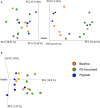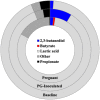A Uniquely Altered Oral Microbiome Composition Was Observed in Pregnant Rats With Porphyromonas gingivalis Induced Periodontal Disease
- PMID: 32211345
- PMCID: PMC7069352
- DOI: 10.3389/fcimb.2020.00092
A Uniquely Altered Oral Microbiome Composition Was Observed in Pregnant Rats With Porphyromonas gingivalis Induced Periodontal Disease
Abstract
Porphyromonas gingivalis is an anaerobic bacterium commonly found in the oral cavity and associated with the development of periodontal disease. P. gingivalis has also been linked to several systemic vascular and inflammatory diseases including poor pregnancy outcomes. Little is known about the changes in the oral flora during pregnancy in connection to P. gingivalis infection. This pilot study aims to explore changes in the oral microbiome due to P. gingivalis inoculation and pregnancy in an in vivo rat model of periodontal disease. A metagenomic sequencing analysis targeting seven of the 16S rRNA gene variable regions was performed for oral samples collected at the following time points: baseline control (week 0), P. gingivalis inoculated (week 11), P. gingivalis inoculated and pregnant rat at necropsy (week 16). A second set of animals were also sampled to generate a sham-inoculated (week 11) control group. We found that the rat oral microbiome profiles were more similar to that of the human oral cavity compared to previous reports targeting one or two 16S variable regions. Overall, there appears to be a relatively stable core microbiome in the oral cavity. As expected, P. gingivalis induced periodontal disease resulted in oral microbiome dysbiosis. During pregnancy, some aspects of the oral microbiome shifted toward a more baseline-like profile. However, population analyses in terms of dissimilarity measures and especially metagenomic based predictions of select characteristics such as cell morphology, oxygen requirement, and major metabolite synthesis showed that pregnancy did not restore the composition of the oral microbiome. Rather, a uniquely altered oral microbiome composition was observed in pregnant rats with pre-established periodontal disease.
Keywords: microbial metabolites; oral microbiome; oxygen requirement; periodontal disease; pregnancy; rat model.
Copyright © 2020 Walkenhorst, Reyes, Perez, Progulske-Fox, Brown and Phillips.
Figures













Similar articles
-
Oral Administration of Porphyromonas gingivalis Alters the Gut Microbiome and Serum Metabolome.mSphere. 2018 Oct 17;3(5):e00460-18. doi: 10.1128/mSphere.00460-18. mSphere. 2018. PMID: 30333180 Free PMC article.
-
Fetal Weight Outcomes in C57BL/6J and C57BL/6NCrl Mice after Oral Colonization with Porphyromonas gingivalis.Infect Immun. 2019 Sep 19;87(10):e00280-19. doi: 10.1128/IAI.00280-19. Print 2019 Oct. Infect Immun. 2019. PMID: 31331955 Free PMC article.
-
Experimental periodontitis induced by Porphyromonas gingivalis does not alter the onset or severity of diabetes in mice.J Periodontal Res. 2013 Oct;48(5):582-90. doi: 10.1111/jre.12041. Epub 2013 Jan 14. J Periodontal Res. 2013. PMID: 23317150
-
Oral ecology and person-to-person transmission of Actinobacillus actinomycetemcomitans and Porphyromonas gingivalis.Periodontol 2000. 1999 Jun;20:65-81. doi: 10.1111/j.1600-0757.1999.tb00158.x. Periodontol 2000. 1999. PMID: 10522223 Review.
-
Porphyromonas gingivalis: major periodontopathic pathogen overview.J Immunol Res. 2014;2014:476068. doi: 10.1155/2014/476068. Epub 2014 Mar 25. J Immunol Res. 2014. PMID: 24741603 Free PMC article. Review.
Cited by
-
Effect of chronic alcohol consumption on oral microbiota in rats with periodontitis.PeerJ. 2024 Aug 12;12:e17795. doi: 10.7717/peerj.17795. eCollection 2024. PeerJ. 2024. PMID: 39148678 Free PMC article.
-
Fetal growth restriction is a host specific response to infection with an impaired spiral artery remodeling-inducing strain of Porphyromonas gingivalis.Sci Rep. 2020 Sep 3;10(1):14606. doi: 10.1038/s41598-020-71762-9. Sci Rep. 2020. PMID: 32884071 Free PMC article.
-
Unveiling the Molecular Crosstalk Between Periodontal and Cardiovascular Diseases: A Systematic Review.Dent J (Basel). 2025 Feb 25;13(3):98. doi: 10.3390/dj13030098. Dent J (Basel). 2025. PMID: 40136726 Free PMC article. Review.
-
Porphyromonas gingivalis-mediated disruption in spiral artery remodeling is associated with altered uterine NK cell populations and dysregulated IL-18 and Htra1.Sci Rep. 2022 Aug 30;12(1):14799. doi: 10.1038/s41598-022-19239-9. Sci Rep. 2022. PMID: 36042379 Free PMC article.
-
The effect of physical and psychological stress on the oral microbiome.Front Psychol. 2023 Jul 5;14:1166168. doi: 10.3389/fpsyg.2023.1166168. eCollection 2023. Front Psychol. 2023. PMID: 37476093 Free PMC article.
References
Publication types
MeSH terms
Substances
Grants and funding
LinkOut - more resources
Full Text Sources
Medical
Research Materials

